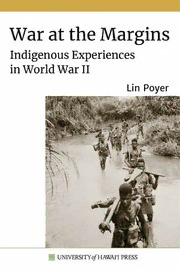Table Of ContentWar at the Margins
War at the Margins
Indigenous Experiences in World War II
•
Lin Poyer
University of Hawai‘i Press
Honolulu
© 2022 University of Hawai‘i Press
Library of Congress Control Number: 2021062389
The Open Access edition of this book is licensed under
Creative Commons Attribution-NonCommercial-
NoDerivatives 4.0 International (CC BY-NC-ND 4.0),
which means that digital editions of the work may be freely downloaded and shared
for non-commercial purposes, provided credit is given to the author. Commercial
uses and the publication of any derivative works require permission from the
publisher. For details, see https://creativecommons.org/licenses/by-nc-nd/4.0/.
The Creative Commons license described above does not apply to any material
that is separately copyrighted.
ISBN 9780824891800 (OA PDF)
ISBN 9780824891794 (OA EPUB)
ISBN 9780824894740 (Kindle)
Publication of the Open Access edition of this book was made possible by grants
from the German Historical Institute, Washington, D.C., and the Institute of East
Asian Studies, UC Berkeley.
Cover art: Soldiers of the New Guinea Infantry Battalion crossing stream in
New Guinea en route to attacking a Japanese position, July 1945. Courtesy of
Australian War Memorial. Photo by Terry Gibson.
S H
The Sustainable History Monograph Pilot
M P Opening Up the Past, Publishing for the Future
This book is published as part of the Sustainable History
Monograph Pilot. With the generous support of the
Andrew W. Mellon Foundation, the Pilot uses cutting-edge
publishing technology to produce open access digital editions
of high-quality, peer-reviewed monographs from leading
university presses. Free digital editions can be downloaded
from: Books at JSTOR, EBSCO, Internet Archive, OAPEN,
Project MUSE, ScienceOpen, and many other open
repositories.
While the digital edition is free to download, read, and share,
the book is under copyright and covered by the following
Creative Commons License: CC BY-NC-ND 4.0. Please
consult www.creativecommons.org if you have questions
about your rights to reuse the material in this book.
When you cite the book, please include the following
URL for its Digital Object Identifier (DOI):
https://doi.org/10125/75827
We are eager to learn more about how you discovered this
title and how you are using it. We hope you will spend a few
minutes answering a couple of questions at this URL:
https://www.longleafservices.org/shmp-survey/
More information about the Sustainable History Monograph
Pilot can be found at https://www.longleafservices.org.
Contents
Acknowledgments ix
Chapter 1
Empires, Nation-States, and Global War at the Margins 1
Chapter 2
Military Service, Citizenship, and Loyalties 11
Chapter 3
Combat in Indigenous Homelands 29
Chapter 4
War Far from Home: Serving Abroad 49
Chapter 5
Strangers in the Homeland 60
Chapter 6
Deploying the “Primitive”: Images and Realities of Indigenous Soldiers 75
Chapter 7
“Martial Myths” and Native Realities 90
Chapter 8
Collateral Damages: Civilian Life in Wartime 101
Chapter 9
Working at War 119
Chapter 10
Building and Destroying the World through War 132
Chapter 11
Indigenous Status in the Postwar World 151
Chapter 12
Indigenous Veterans in Combatant Nations 165
vii
viii Contents
Chapter 13
The Pasts and Futures of World War II for Indigenous Communities 178
Chapter 14
Beyond Nation-States 193
Notes 203
References 259
About the Author 307
Acknowledgments
I must first honor those who lived the experiences described in this book, and
those who have preserved memories of the World War II era. I am grateful to the
historians, anthropologists, and other researchers, especially Indigenous schol-
ars; to librarians and archivists; and to the people who shared their recollections
for future generations. I have been able to use only a portion of the published
and unpublished resources available, which contain many historical treasures.
The scope of this work has been inspired by the Bahá’í “world-embracing
vision” of the oneness of humanity. Writing it, appropriately, has required the
generous assistance of colleagues and friends from around the world. In com-
pleting this book, I appreciate the comments and help of University of Hawai’i
Press Executive Editor Masako Ikeda, reviewer Lamont Lindstrom, and two
anonymous reviewers. Readings by David Poyer (whose own novels of the mod-
ern US Navy offer much insight into war and warriors), Naia Poyer, and Robert
Kelly improved the manuscript. For specific information, advice, and other sup-
port, I thank Judith A. Bennett, Robert Hitchcock, Veli-Pekka Lehtola, Anil
Raman, Oula Seitsonen, Roland Thorstensson, Futuru Tsai, Taarna Valtonen,
and others who spoke with me about their special knowledge of the topic, and,
for institutional support, the University of Wyoming. For permissions for use
of quotations, maps, photographs, and information about them, thanks to Car-
canet Press, Journal of Pacific History, the Center for Pacific Islands Studies of
the University of Hawai’i at Manoa, Stephan Dudeck, Robert Kelly, Robert and
Sylvia May and the Kohima Educational Trust, Alaska Museum of the North
(especially Mareca Guthrie), Australian War Memorial, and the Alexander
Turnbull Library, National Library of New Zealand (especially Pamela Lovis).
In memory of all our families, may the trials of the past bring us to a future
of greater freedom and peace.
ix

